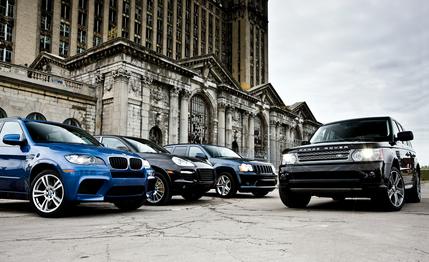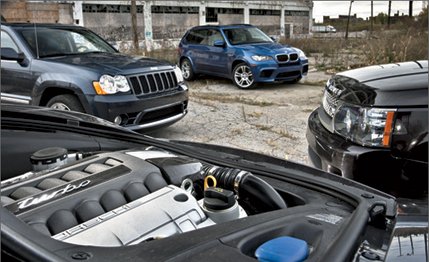
 Comparison Tests
Comparison Tests




Let’s be clear: In the matter of mammoths, we understand the distinction between woolly and hairy. Woolly mammoths were the elephantine creatures that disappeared about 8000 to 10,000 years ago. Guys hunted ’em with pointed sticks, which was reportedly a hairy experience.
But hairy also applies to this collection: the BMW X5 M, the Jeep Grand Cherokee SRT8, the Land Rover Range Rover Sport Supercharged, and the Porsche Cayenne Turbo S. Mammoths all—not a one under 4700 pounds or propelled by less than 420 horsepower. And all of them astoundingly quick on their feet, particularly for creatures in this weight class. Astoundingly quick, period, come to think of it. The slowest of the lot—if slow is the right word—rumbles to 60 mph in 5.1 seconds.
What does it all mean? In an age of escalating alphabetic concerns—MPG, CO2, NOX—this foursome may seem seriously out of step and as ripe for extinction as the old woollies. There would be big gas-guzzler fees attached to their already weighty price tags were it not for their exempt status—they’re trucks. The best EPA ratings belong to the Porsche—12 mpg city and 19 highway, numbers that are hard to associate with the word “best.” Three of the four averaged 14 mpg during our 450-mile tour of western Michigan, and the fourth, just 13.
You could excuse this rabid thirst if there was real work involved—heavy towing, for example. But that’s not the case, and, in fact, at least one of these muscle-bound mastodons is rated for just 3500 pounds. You can tow that much with a minivan. While some of the others can drag a lot more than that—the Porsche and the Range Rover are both rated for 7716 pounds—we’ll bet you won’t see many of these super-utes held back by trailers. They are not rational. They exist for going improbably fast, for astonishing the Corvette driver in the other lane when the light turns green. Jaysez! What the hell was that?
We should note that the super-ute precedent was established long ago. Remember the Lamborghini LM002? Conceived as an off-road-capable military scout vehicle, it sported a 5.2-liter Lamborghini V-12 fed by six Weber carburetors (remember carburetors?) to the tune of 444 horsepower and 368 pound-feet of torque. The people who develop vehicles for military applications don’t seem to worry too much about mass, and that was true with this one: 6780 pounds, which makes our contemporary quartet look almost dainty.


But even burdened with well over three tons, the V-12 was able to push that big Lambo to 60 mph in 7.7 seconds, which was pretty quick in 1987. More important, it looked like nothing else on U.S. roads, making its $120,000 price tag and 8-mpg thirst acceptable to seekers of exclusivity. But, of course, a gallon of gas was about a buck back then, and it was a much different world.
Our contemporary mammoths don’t have the LM002’s unique visual distinction. Basically, these are all familiar faces, high-output variations of less-explosive models; their distinctions are subdermal. But those are big distinctions. We’re also looking at some big price disparities. That factor, plus the sharply differing personalities of the four vehicles, made scoring a challenge. But as always, we emerged with distinctions of our own.